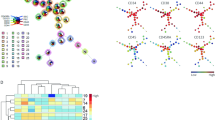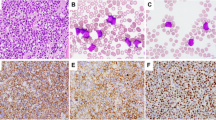Abstract
Biphenotypic acute leukemia (BAL) is a rare, difficult to diagnose entity. Its identification is important for risk stratification in acute leukemia (AL). The scoring proposal of the European Group for the Classification of Acute Leukemia (EGIL) is useful for this purpose, but its performance against objective benchmarks is unclear. Using the EGIL system, we identified 23 (3.4%) BAL from among 676 newly diagnosed AL patients. Mixed, small and large blast cells predominated, with FAB M2 and L1 constituting the majority. All patients were positive for myeloid (M) markers and either B cell (B) (17 or 74%) or T cell (T) (8 or 34%) markers with two exceptional patients demonstrating trilineage phenotype. Six (50%) of studied M-B cases were positive for both IGH and TCR. In six (26%) patients myeloid lineage commitment was also demonstrable by electron cytochemistry. Abnormal findings were present in 19 (83%) patients by cytogenetics/FISH/molecular analysis as follows: t(9;22) (17%); MLL gene rearrangement (26%); deletion(6q) (13%); 12p11.2 (9%); numerical abnormalities (13%), and three (13%) new, previously unreported translocations t(X;6)(p22.3;q21); t(2;6)(q37;p21.3); and t(8;14)(p21;q32). In conclusion, the EGIL criteria for BAL appear robust when compared against molecular techniques that, if applied routinely, could aid in detecting BAL and help in risk stratification.
This is a preview of subscription content, access via your institution
Access options
Subscribe to this journal
Receive 12 print issues and online access
$259.00 per year
only $21.58 per issue
Buy this article
- Purchase on Springer Link
- Instant access to full article PDF
Prices may be subject to local taxes which are calculated during checkout
Similar content being viewed by others
References
Jaffe ES, Harris NL, Stein H, James W . Vardiman, Pathology and Genetics, Tumor of Haematopoietic and Lymphoid Tissues. IARC Press: Lyon, 2001.
Bain BJ, Barnett D, Linch D, Matutes E, Reilly JT . Revised guideline on immunophenotyping in acute leukemias and chronic lymphoproliferative disorders. Clin Lab Haem 2002; 24: 1–13.
McCulloch EA . Stem cells in normal and leukemic hemopoiesis. Henry Stratton Lecture 1982. Blood 1983; 62: 1–13.
Sawyers CL, Denny CT, Witte ON . Leukemia and the disruption of normal hematopoiesis. Cell 1991; 64: 337–350.
Thalhammer-Scherrer R, Mitterbauer G, Simonitsch I, Jaeger U, Lechn K, Schneider B et al. The immunophenotype of 325 adult acute leukemias: relationship to morphologic and molecular classification and proposal for a minimal screening program highly predictive for lineage discrimination. Am J Clin Pathol 2002; 117: 380–389.
Altman AJ . Clinical features and biological implications of acute mixed lineage (hybrid) leukemias. Am J Pediatr Hematol Oncol 1990; 12: 123–133.
Hanson CA, Abaza M, Sheldon S, Ross CW, Schnitzer B, Stoolman LM . Acute biphenotypic leukaemia: immunophenotypic and cytogenetic analysis. Br J Haematol 1993; 84: 49–60.
Bene MC, Castoldi G, Knapp W, Ludwig WD, Matutes E, Orfao A, et al., For the European Group for the Immunological Characterization of Leukemias (EGIL). Proposals for the immunological classification of acute leukemias. Leukemia 1995; 9: 1783–1786.
Legrand O, Perrot JY, Simonin G, Baudard M, Cadiou M, Blanc C et al. Adult biphenotypic acute leukemia: an entity with poor prognosis which is related to unfavourable cytogenetics and P-glycoprotein over-expression. Br J Haematol 1998; 100: 147–155.
Sulak LE, Clare CN, Morale BA, Hansen KL, Montiel MM . Biphenotypic acute leukemia in adults. Am J Clin Pathol 1990; 94: 54–58.
Shen Y, Li J, Xue Y, Zhu M, Lu D, Geng M et al. Acute biphenotypic leukemia in the adults. Zhonghua Zhong Liu Za Zhi 2002; 24: 375–377.
Schmitt-Graff A, Jurgens H, Reifenhauser A, Schwamborn D, Gobel U . Childhood biphenotypic leukemia: detection of mixed lymphoid and myeloid populations in bone marrow specimens. Hum Pathol 1998; 19: 651–656.
Buccheri V, Matutes E, Dyer MJS, Catovsky D . Lineage commitment in biphenotypic acute leukemia. Leukemia 1993; 7: 919–927.
Killick S, Matutes E, Powles RL, Hamblin M, Swansbury J, Treleaven JG et al. Outcome of biphenotypic acute leukemia. Haematologica 1999; 84: 699–706.
Carbonell F, Swansbury J, Min T, Matutes E, Farahat N, Buccheri V et al. Cytogenetic findings in acute biphenotypic leukaemia. Leukemia 1996; 10: 1283–1287.
Shetty V, Chitale A, Matutes E, Buccheri V, Morilla R, Catovsky D . Immunological and ultrastructural studies in acute biphenotypic leukemia. J Clin Pathol 1993; 46: 903–907.
Moscinski LC, Nowell PC, Hoxie JA, Berger MS, Prytowsky MB . Surface marker analysis and karyotype distinguish acute biphenotypic leukemia from acute myelogenous leukemia expressing terminal deoxynucleotidyl transferase. Cancer 1991; 68: 2161–2168.
Brigaudau C, Bilhou-Nabera C . del (6q) abnormalities in lymphoid malignancies. Atlas Genet Cytogenet Oncol Haematol 1998, URL: http://www.infobiogen.fr/services/chromcancer/Anomalies/del6qID1148.html.
Al-Qurashi F, Owaidah T, Iqbal MA, Aljurf M . Trisomy 4 as the sole karyotypic abnormality in a case of acute biphenotypic leukemia with T-lineage markers in minimally differentiated acute myelocytic leukemia. Cancer Genet Cytogenet 2004; 150: 66–69.
Brumpt C, Delabesse E, Beldjord K, Davi F, Cayuela JM, Millien C et al. The incidence of clonal T-cell receptor rearrangements in B-cell precursor acute lymphoblastic leukemia varies with age and genotype. Blood 2000; 96: 2254–2261.
Chen Z, Le Paslier D, Dausset J, Degos L, Flandrin G, Cohen D et al. Human T cell gamma genes are frequently rearranged in B-lineage acute lymphoblastic leukemias but not in chronic B-cell proliferations. J Exp Med 1987; 165: 1000–1015.
Height SE, Swansbury GJ, Matutes E, Treleaven JG, Catovsky D, Dyer MJS . Analysis of clonal rearrangements of the Ig heavy chain locus in acute leukemia. Blood 1996; 87: 5242–5250.
Szczepanski T, Willemse MJ, Brinkhof B, van Wering ER, van der Burg M, van Dongen JJM . Comparative analysis of Ig and TCR gene rearrangements at diagnosis and at relapse of childhood precursor B-ALL provides improved strategies for selection of stable PCR targets for monitoring of minimal residual disease. Blood 2002; 99: 2315–2323.
Author information
Authors and Affiliations
Corresponding author
Rights and permissions
About this article
Cite this article
Owaidah, T., Beihany, A., Iqbal, M. et al. Cytogenetics, molecular and ultrastructural characteristics of biphenotypic acute leukemia identified by the EGIL scoring system. Leukemia 20, 620–626 (2006). https://doi.org/10.1038/sj.leu.2404128
Received:
Revised:
Accepted:
Published:
Issue Date:
DOI: https://doi.org/10.1038/sj.leu.2404128
Keywords
This article is cited by
-
Mixed phenotype acute leukemia with PML-RARα positive: a case report and literature review
Molecular Cytogenetics (2021)
-
An update on classification, genetics, and clinical approach to mixed phenotype acute leukemia (MPAL)
Annals of Hematology (2018)
-
Immunophenotype, microRNA expression and cytogenetic characterization of acute leukemias of ambiguous lineage
Comparative Clinical Pathology (2017)
-
The Philadelphia chromosome in leukemogenesis
Chinese Journal of Cancer (2016)
-
Outcomes of allogeneic hematopoietic cell transplantation in patients with biphenotypic acute leukemia
Annals of Hematology (2016)



